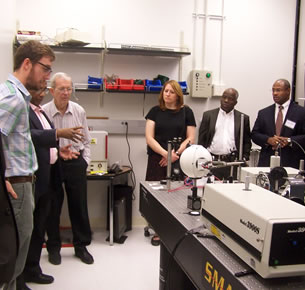UTSA hosts two-day National Science Foundation visit with research presentations

UTSA physics professor discusses nanoparticle research utilizing lasers

UTSA physics professor discusses nanoparticle research utilizing lasers
(Nov. 7, 2011) -- The UTSA Department of Physics and Astronomy recently hosted representatives from the National Science Foundation (NSF) and visiting university professors to learn more about the department's participation as a member of the Partnership for Research and Education in Materials (PREM).
The two-day visit included research and poster presentations by physics faculty members and students as well as tours of UTSA physics laboratories.
Miguel Yacaman, professor of astronomy and chair of the Department of Physics and Astronomy, introduced the group to "Helenita," one of the world's most powerful electron microscopes. The microscope was purchased in January 2010 with the support of a $1.2 million gift from the Robert J. Kleberg Jr. and Helen C. Kleberg Foundation.
The JEOL transmission electron microscope will assist in development of new cancer therapies and disease treatments by allowing nanotechnology researchers to see samples magnified 20 million times their original size.
Yacaman said the microscope is being used extensively by UTSA faculty and students. Additionally, the microscope is being used for an hourly rate by faculty members outside the university and researchers in the private sector.
While on campus, PREM site visitors also had the opportunity to tour the laboratory of Dhiraj Sardar, Ashbel Smith Professor of Physics, who uses lasers for his nanotechnology research. Sardar was the principal investigator who helped the department acquire a five-year $2.7 million grant in 2009 from the NSF. The grant is designed to help increase the participation of underrepresented minorities and advance the understanding of the fundamental science of nanomaterials. Additionally, the grant enhances the educational outreach programs for high school and junior college students.
The department's investments in sophisticated world-class, high-technology equipment and nanotechnology research have paid dividends as the interest in physics continues to grow. Since the UTSA doctoral degree program was established in 2005, eight students have earned Ph.D.s in physics. Currently, 63 students are enrolled in the program, ranking it the fifth largest in Texas.
Events
This event will acknowledge graduating seniors from the McNair Scholars program at UTSA before inducting the new cohort of scholars into the program.
North Paseo Building (NPB 5.140), Main CampusAt this memorable celebration, UTSA graduates will be introduced one-by-one to cross the stage and accept their doctoral degrees.
Arts Building Recital Hall, Main CampusRoadrunner Walk is an event for graduating students to have a memorable walk on campus to celebrate an important milestone and their achievements. Graduates will walk along the Paseo while being celebrated by the UTSA community, friends, and family members.
Student Union Paseo, Main CampusCelebrate the accomplishments of College of Education and Human Development, College for Health, Community and Policy, College of Sciences and University College.
Alamodome, 100 Montana St.Celebrate the accomplishments of Alvarez College of Business, College of Liberal and Fine Arts and Klesse College of Engineering and Integrated Design.
Alamodome, 100 Montana St.

